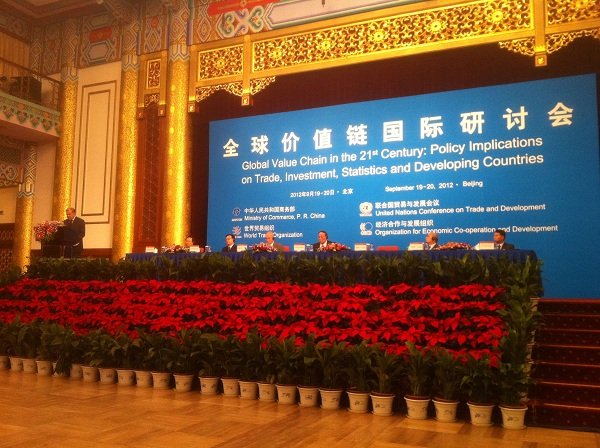"The investment–trade nexus is leading to a world in which … policymakers in the twenty-first century cannot afford to ignore the implications of GVCs for their industrial, investment and trade policies,” UNCTAD Secretary-General Supachai Pantichpakdi told the high-level panel convened yesterday after the opening plenary of the conference on "Global Value Chain in the 21st Century" jointed organised by China's Ministry of Commerce, UNCTAD, OECD and the WTO in Beijing.
The high-level panel on “How global value chains have altered the landscape of international trade and investment” was composed of the H.E. Mr. Gao Hucheng, Vice Minister of the Ministry of Commerce of China, OECD Director General Angel Gurria, WTO Director General Pascal Lamy, and the UNCTAD Secretary-General. It focussed on both how GVCs impact on trade and investment and, more specifically, how they translate into growth, jobs, development and poverty alleviation.

Dr. Supachai focused especially on how policymakers can respond to the challenge of GVCs for economic and social upgrading by creating synergies between investment, trade and development policies. Drawing upon his experience of developments in Asia, as well as analysis by UNCTAD, he made a number of key points:
First, he argued that in addition to FDI another key feature of GVCs is the prominent use of non-equity modes (NEMs) – such as outsourcing manufacturing processes to foreign suppliers – by transnational corporations (TNCs), a topic covered in the World Investment Report 2011.
Secondly, he cautioned that GVCs are not always a blessing. For example, developing countries that manage to enter GVCs can suffer from “the middle income trap”, and the departure of “footloose” investment and NEMs.
Thirdly, it is therefore important for countries to have an integrated “investment policy framework for sustainable development” to ensure that they can both target GVCs effectively and put in place the capabilities – for instance a domestic supply base – to encourage viable growth. For example, by so doing governments establish activities which provide employment without being “flighty” and encourage an ascending path into higher segments of GVCs.
The potential for "economic" or "industrial" upgrading within GVCs was detailed further by the Secretary-General during the session since this is a critical issue for developing countries.
It is an area with a significant body of analytical research by UNCTAD and other organizations; and some results of this body of work touched upon in the panel session included:
The governance pattern of a GVC determines the type of upgrading that is likely to occur. One key aspect of this is how much economic or positional power a TNC has vis-à-vis local companies in developing countries; in other words, the "balance of power" is important.
Economic upgrading is not automatic and, for instance, various industries exhibit different propensities for economic and social upgrading. For example, in “traditional” industries such as garments, TNCs often intervene directly in their suppliers’ production processes, to improve efficiency and to attain higher international quality standards for products. But support for upgrading is limited to process and product upgrading, with functional upgrading discouraged. In more “modern” industries, such as automobiles, the sophistication of the products and processes limits upgrading unless suppliers have sufficient technological and other capabilities.
Industrial clusters can heighten the prospects for upgrading in GVCs, but can in some cases hinder innovation. Clusters offer local firms a means to overcome the financial, organizational, technological and infrastructural limitations preventing their entry into GVCs. However, the risk is that clusters simply facilitate collective efficiencies for tool sharing, labour pooling and access to inputs, but are devoid of innovation.
Local firms participating in a number of GVCs (either different sectors or the chains of a number of TNCs) have better upgrading prospects. For example, firms can learn from designs supplied by one customer and then make adaptations and use modified designs to supply other customers in other markets. In a similar vein, by participating in multiple chains – global, regional, and domestic – it is possible for local firms to overcome the constraints inherent in upgrading in any one of these.
Economic upgrading does not automatically lead to socially beneficial outcomes. Indeed, sometimes, it is associated with harmful social outcomes. In general, participation in GVCs leads to improvements in working conditions and skilling, as well as a large increase in employment, but very little increase in wages. On the negative side, greater efficiency can also lead to an increased casualization of labour. In other cases, e.g. the agro-food sector, process improvements in GVCs have been accompanied by weak pro-poor, environmental and gender outcomes.
The high level panel discussion was followed by a meeting between Vice-Premier Wang Qishan and the heads of the three co-organising international agencies.



